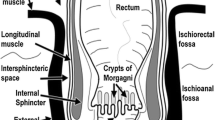Abstract
The failure of external anal sphincter repair may relate to sphincter atrophy where muscle fibers are replaced by fat, seen on MRI due to the differing signals returned by fat and muscle tissue. Manometry, electrophysiology, and MRI with an endocoil were performed on 34 fecally incontinent patients with intact sphincters on endosonography. The area of the external sphincter was measured in the midcoronal plane, and the percentage fat content calculated. Sphincter muscle area correlated strongly with squeeze pressure (P < 0.001) but not with percentage fat content. There was no relationship between percentage fat and age, weight, anal sensation, squeeze pressure, sphincter length or width, or pudendal nerve terminal motor latency. There was a trend for smaller sphincters to contain a higher percentage fat content (P = 0.059). MRI has established a relationship between function and external sphincter bulk, but not fat content, although smaller muscles may contain more fat.
Similar content being viewed by others
References
Roig JV, Villoslada C, Lledo S, Solana A, Buch E, Alos R, Hinojosa: Prevalence of pudendal neuropathy in fecal incontinence. Results of a prospective study. Dis Colon Rectum 38:952–958, 1995
Henry MM: The role of pudendal nerve innervation in female pelvic floor function. Curr Opin Obstet Gynecol 6:324–325, 1994
Parks AG, Swash M, Urich H: Sphincter denervation in anorectal incontinence and rectal prolapse. Gut 18:656–665, 1977
Wexner SD, Marchetti F, Salanga VD, Corredor C, Jagelman DG: Neurophysiologic assessment of the anal sphincters. Dis Colon Rectum 34:606–612, 1991
Swash M: Pathophysiology of idiopathic (neurogenic) faecal incontinence. Ann R Coll Surg Engl XX:22–24, 1983
Stoker J, Lameris JS: Endoanal magnetic resonance imaging. Acta Gastroenterol Belg 60:274–277, 1997
deSouza NM, Puni R, Zbar A, Gilderdale DJ, Coutts GA, Krausz T: MR imaging of the anal sphincter in multiparous women using an endoanal coil: Correlation with in vitro anatomy and appearances in fecal incontinence. Am J Roentgenol 167:1465–1471, 1996
Astrom KE, Adams RD, Walton J (eds): Disorders of Voluntary Muscle, 1st ed, Vol. 5. Pathology of Human Skeletal Muscle. Edinburgh/London/Melbourne/New York, Churchill Livingstone, 1981
Jennekens FGI, Mastaglia FL, Walton J (eds): Skeletal Muscle Pathology, 3rd ed. Vol. 5. Neurogenic Disorders of Muscle. Edinburgh/London/Melbourne/New York, Churchill Livingstone, 1982, pp 204–234
Frudinger A, Bartram CI, Halligan S, Kamm M: Examination techniques for endosonography of the anal canal. Abdo Imaging 23:301–303, 1998
Bland JM, Altman DG: Statistical methods for assessing agreement between two methods of clinical measurement. Lancet 1:307–310, 1986
Goligher JC, Leacock AG, Brossy JJ: The surgical anatomy of the anal canal. Br J Surg 43:51–61, 1955
deSouza NM, Puni R, Kmiot WA, Bartram CI, Hall AS, Bydder GM: MRI of the anal sphincter. J Comput Assist Tomogr 19:745–751, 1995
Hussain SM, Stoker J, Zwamborn AW, Den HJ, Kuiper JW, Entius CA, Lameris JS: Endoanal MRI of the anal sphincter complex: Correlation with cross-sectional anatomy and histology. J Anat 189:677–682, 1996
Engel AF, Kamm MA, Bartram CI, Nicholls RJ: Relationship of symptoms in faecal incontinence to specific sphincter abnormalities. Int J Colorect Dis 10:152–155, 1995
Schafer R, Heyer T, Gantke B, Schafer A, Frieling T, Haussinger D, Enck P: Anal endosonography and manometry: Comparison in patients with defecation problems. Dis Colon Rectum 40:293–297, 1997
Sultan AH, Kamm MA, Hudson CN, Nicholls JR, Bartram CI: Endosonography of the anal sphincters: Normal anatomy and comparison with manometry. Clin Rad 49:368–374, 1994
Felt-Bersma RJ, van Baren R, Koorevaar M, Strijers RL, Cuesta MA: Unsuspected sphincter defects shown by anal endosonography after anorectal surgery. A prospective study. Dis Colon Rectum 38:249–253, 1995
Sultan AH, Kamm MA, Hudson CN, Bartram CI: Effect of pregnancy on anal sphincter morphology and function. Int J Colorect Dis 8:206–209, 1993
Eckardt VF, Jung B, Fischer B, Lierse W: Anal endosonography in healthy subjects and patients with idiopathic fecal incontinence. Dis Colon Rectum 37:235–242, 1994
Aronson MP, Lee RA, Berquist TH: Anatomy of anal sphincters and related structures in continent women studied with magnetic resonance imaging. Obstet Gynecol 76:846–851, 1990
Gantke B, Schafer A, Enck P, Lubke HJ: Sonographic, manometric, and myographic evaluation of the anal sphincters morphology and function. Dis Colon Rectum 36:1037–1041, 1993
Haas PA, Fox TA: Age-related changes and scar formations of perianal connective tissue. Dis Colon Rectum 23:160–169, 1990
Klosterhalfen B, Offner F, Topf N, Vogel P, Mittermayer C: Sclerosis of the internal anal sphincter–A process of aging. Dis Colon Rectum 33:606–609, 1990
Speakman CT, Hoyle CH, Kamm MA, Swash M, Henry MM, Nicholls RJ, Burnstock G: Abnormal internal anal sphincter fibrosis and elasticity in fecal incontinence. Dis Colon Rectum 38:407–410, 1995
Rieger NA, Sarre RG, Saccone GT, Schloithe AC, Wattchow DA: Correlation of pudendal nerve terminal motor latency with the results of anal manometry. Int J Colorect Dis 12:303–307, 1997
Vaccaro CA, Cheong DM, Wexner SD, Nogueras JJ, Salanga VD, Hanson MR, Phillips RC: Pudendal neuropathy in evacuatory disorders. Dis Colon Rectum 38:166–171, 1995
Engel AF, Kamm MA: The acute effect of straining on pelvic floor neurological function. Int J Colorect Dis 9:8–12, 1994
Percy JP: Anatomy and innervation of the pelvic floor. Ann R Coll Surg Engl XX:15–16, 1983
Snooks SJ, Swash M, Henry MM, Setchell M: Risk factors in childbirth causing damage to the pelvic floor innervation. Br J Surg 72:S15–S17, 1985
Author information
Authors and Affiliations
Rights and permissions
About this article
Cite this article
Williams, A., Malouf, A., Bartram, C. et al. Assessment of External Anal Sphincter Morphology in Idiopathic Fecal Incontinence with Endocoil Magnetic Resonance Imaging. Dig Dis Sci 46, 1466–1471 (2001). https://doi.org/10.1023/A:1010639920979
Issue Date:
DOI: https://doi.org/10.1023/A:1010639920979




